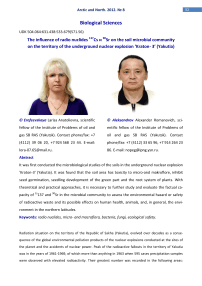The influence of radio nuclides 137Cs и 90Sr on the soil microbial community on the territory of the underground nuclear explosion ‛Kraton- 3’ (Yakutia)
Автор: Erofeevskaya L.A., Alexandrov A.R.
Журнал: Arctic and North @arctic-and-north
Рубрика: Biological Sciences
Статья в выпуске: 8, 2012 года.
Бесплатный доступ
It was first conducted the microbiological studies of the soils in the underground nuclear explosion ‛Kraton-3’ (Yakutia). It was found that the soil area has toxicity to micro-and makroflore, inhibit seed germination, seedling development of the green part and the root system of plants. With theoretical and practical approaches, it is necessary to further study and evaluate the factual capacity of Cs137 and 90Sr in the microbial community to assess the environmental hazard or safety of radioactive waste and its possible effects on human health, animals, and, in general, the environment in the northern latitudes.
Radio nuclides, micro- and macroflora, bacteria, fungi, ecological safety
Короткий адрес: https://sciup.org/148320406
IDR: 148320406 | УДК: 504.064:631.438:533.679(571.56)
Текст научной статьи The influence of radio nuclides 137Cs и 90Sr on the soil microbial community on the territory of the underground nuclear explosion ‛Kraton- 3’ (Yakutia)
Radiation situation on the territory of the Republic of Sakha (Yakutia), evolved over decades as a consequence of the global environmental pollution products of the nuclear explosions conducted at the sites of the planet and the accidents of nuclear power. Peak of the radioactive fallouts in the territory of Yakutia was in the years of 1961-1969, of which more than anything in 1963 when 595 cases precipitation samples were observed with elevated radioactivity. Their greatest number was recorded in the following areas:
Oimyakon - 37 cases; Verkhnekolymsk, Aldan, Bulun - 32 cases; Neryungri - 28 cases; Ust Yanskiy, Sred-nekolymsky - 27 cases. The maximum value equal to 1779.3 fallout Bk/km2 per day [1].
In the period from 1974 to 1987 in the republic were held twelve peaceful nuclear explosions, one of which, "Kraton-3", was held for the purpose of the deep seismic sounding of the sedimentary cover of the earth's crust, was alert, with emission in the atmosphere and the soil surface radioactive decay products.
The object of an underground nuclear explosion (UNE) "Kraton-3" is in the territories of Verkhnevil-yuisk, Morkokinskogo area of the north-taiga, subzone permafrost-taiga of the boreal region of the Eastern Siberia, characterized by continuous permafrost zone of [2], 40 km to the east of the village Aikhal on the right bank of the Markha (left tributary Viluy), 160 m from the water (Figure 1-2).
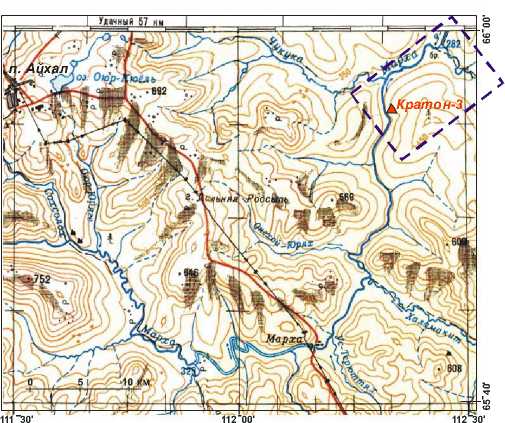
Pic. 1. Location map of the object UNE "Kraton-3"
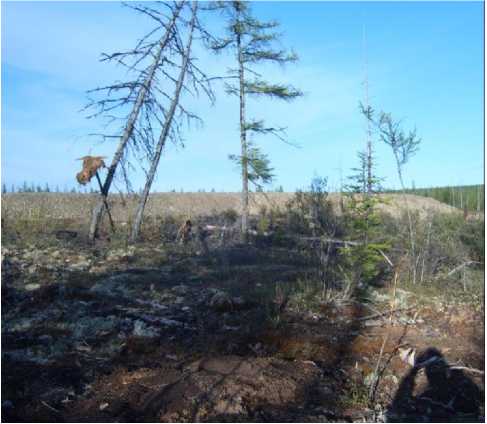
Pic. 2. General view of the sarcophagus "Kraton-3"
The maximum depth of the seasonal thawing or power seasonally thawed layer is 0.6 m - for peat,
1.0 m - for sandy loam and 2.0 m - for sand [3].
"Fighting" well has the coordinates of 65 ° 55 ‘ 31,6 ‘ ‘ 'north latitude, 112 ° 19 ‘ 57,8 ‘ ‘ east; altitude point of its inception above sea level - 308.99 m
In regard to the hydro geological area UNE "Kraton-3" refers to Olenyekskiy krioartezianskiy basin. [4]
According to the borders of the object, can be named several types: upperfrozen waters of the seasonally thawed layer of the underflow and podozernyh taliks, Lower Ordovician interpermafrost (oldondin-skaya Formation), Upper (morkokinskaya and Markha formation), medium-(chukukskaya suite) and Cambrian subpermafrost aquifer systems [5, 6].
Geological cross-section to a depth of 12-14 m is composed of alluvial sediments of Quaternary system (QIII3 +4- QIV), sand mixed with gravel and loam. Below, to a depth of 252-270 m, lies sequence of alternating lime stones and shales of the Lower Ordovician, dismembered at sohsodohskuyu (O1shs), ol-dondinskuyu (O1ol) and morkokinskuyu (O1mrk) suite. The lower part of the studied section to a depth of
584 m is composed of limestone and dolomite with interbedded shales of the Upper Cambrian (Є3). In the interval 165-185 m greeted hydroscopic horizon [6, 7, 8].
The main types of the soil survey areas are sod-carbonate and humus calcareous soils, formed on elyuviodelyuvii carbonate rocks - dolomite and limestone [9, 10]. Carbonate deposits are characterized by quiet gamma-background, with fluctuations in the level of radioactivity in the range 4.7 mR / h [11].
The first decontamination works at the site of the facility "Kraton-3" was held in 1981 on the project VNIPI Survey Systems (Moscow). Poured over the mouth of the mine hill soil 3 m high with a prohibiting sign-frame. Vault buried objects and wellhead platform was diked bulk up to 1 m.
In 1993, on the area of the radio-ecological expedition "Markha-93" were laid experiments with natural zeolite deposits Khonguruu (Suntarsky District, Western Yakutia) as a protective barrier. It was found that the Yakut mineral can absorb and accumulate radionuclides, which is consistent with the data [12] for the study of the sorption properties of zeolites klinoptilolitovogo type [13]. Expedition along with Cs and Sr isotopes found in the facility, "Kraton-3" presence 60Co, 137Cs, Pu and 125Sb in quantities exceeding global levels repeatedly. In particular, in lichens obtained from the dry forest near the track axis, the content 239, 240Pu reached the level of 7400 Bq / kg at 2.7 Bq / kg in the control area. [7]
Since then, the facility held about thirty research, and radio-ecological monitoring activities.
The results of a comprehensive site survey UNE "Kraton-3" over several years have shown [3, 9, 10, 13, 14, 15, 16, 17]:
at the site of UNE "Kraton-3", which in 1981 was removed soil with vegetation and soil part, clearly visible pattern of distribution along the axis of maximum pollution radioactive trail with a decrease to the periphery;
contamination levels of soil 137Cs, 90Sr and 239, 240Pu exceed levels by 2-4 global order;
total stock of 90Sr on the project "Kraton-3" dominated much (2-3 times) of 137Cs;
Detailed radiometric surveying at the site of UNE "Kraton-3" revealed two local spots of contamination with high levels of gamma radiation, one of which is located directly at the mouth of the well, where the level of gamma radiation reaches the maximum 125 mR / h, the second - 150 meters from the estuary to the north with two peaks: 230 and 250 mR / hr;
the object "Kraton-3" significant levels of contamination of the surface layers of soil and vascular plants were also found at the site and the area of reclamation. In this case, on a section of the stock of 137Cs and 90Sr in the soil in 2000 times the global level of pollution;
stored in the contamination, and the need to work to delay the migration of radionuclides.
In 2007-2008, the ecological group from the Institute of Oil and Gas Sciences held expeditions in order to monitor for possible migration paths of 137Cs and 90Sr from the sarcophagus, "Kraton-3" and the construction of nine additional protective geochemical barriers based on zeolite materials deposit Khonguruu.
In order to create land cover on-site burial ground was laid two sites with seed pyreynika Siberian (Clinelymus sibiricus). In one of the delyanok were sown the seeds and fertilizers without sorbents to another - seeding perennial conducted after making zeolite fraction 1-8 mm and complex fertilizer "Hongurin" developed by employees IPNG RAS [18]. Thus, to migration of radionuclides has been put in the form of a double barrier of zeolite sorbent materials, and will serve as the Siberian pyreynik shielding material providing the accumulation of nutrients in the sod layer [19].
In a A year in the experimental site with the introduction of zeolite and hongurina appeared steady growth of grass. Results of the first experience of creating a land-for-shelter at the site of UNE "Kraton-3"
are shown in Pic. 3 and 4.
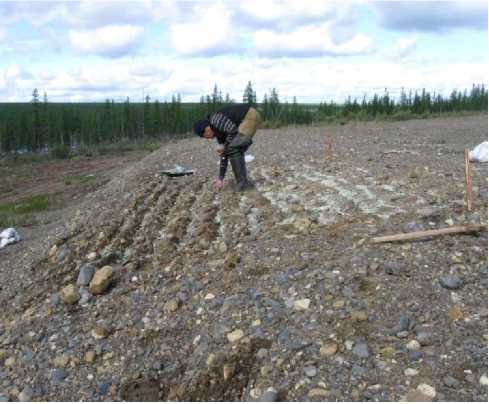
Pic. 3. Sowing seeds in the section with zeolite and hon-gurinom
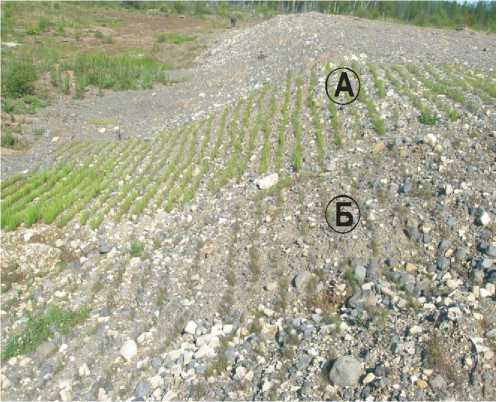
Pic 4. The result of a year of seeding: A - site with zeolite and hongurinom, B - only the seeds
In 2008, for the first time the soils and the subsoils of the territory UNE "Kraton-3" were studied on microbiological criteria. As a control, were analyzed by the "background-clean" soil forest village Aikhal and Yakutsk.
Soil samples were collected by the sampler Adelman EIJKELKAMP company products according to IEC and GOST 17.4.3.01-83 17.4.4.02-8 [20, 21]. Radiometric measurement of gamma-radiation was carried out in accordance with conventional methods using a radiometer SRP-68-01 № 3189. [22] Cultivation and identification of microorganisms was performed in accordance with GOST approved and well-known teaching materials [23-25].
Studies have shown that the migration of radio nuclides at the object continues. Over 14 years zeolite adsorbed 137Cs on the level of 63,7 ± 7 and 90Sr - 26400 ± 5300 Bq / kg [26]. All resechers of the soils UNE "Kraton-3" had a strong alkaline reaction with the environment and low humidity. Total microbial population (TMC) in the soils of the object did not differ much in different samples and ranged from 3.2 to 617 thousand colony forming units (CFU) per 1 g of the dry weight (ACB) of the soil, which is 3-4 times less than in the control samples' background-clean "forest soils (Table 1).
Table 1
|
ML-3 |
UNE "Kraton-3", the dry zone forests |
8,53 |
0,789 |
21,1 |
29,90 |
|
|
near the coastal slope of the Markha |
river |
|||||
|
F-2 |
UNE"Kraton-3" left bank of the Creek Bezzimyanni |
8,46 |
0,476 |
52,4 |
617,52 |
|
|
K-1 |
Forest village. Aikhal, Mirny District |
zone, |
7,32 |
0,508 |
49,2 |
30661,30 |
|
K-2 |
Forest |
zone, |
7,24 |
0,432 |
56,8 |
863117,00 |
Yakutsk (Vilyuisk tract)
The studied soils objects contain fungi and bacteria that can absorb radioactive substances that was the beginning of the new tests to study the possibility of using microorganisms as sorbents for the treatment of radioactive waste.
In general, the soils of the study area on the microbiological index regarded as poor. The species composition of the soil micro flora object of diversity and not much lower than those in control of the
"background-clean" soil (Table 2).
Table 2
The fixation of the populations of the soil micro organisms
|
№ sample |
The selected micro flora |
|||
|
Order |
Kind |
Sort |
Type |
|
|
Eubacteriales |
Bacillacae |
Bacillus |
agglomeratus |
|
|
МЛ-1 |
Eubacteriales |
Pseudomonadaceae |
Pseudomonas |
pseudoalcaligenes |
|
Actinomycetаles |
Micrococcaceae |
Sarcina |
sp. |
|
|
Eubacteriales |
Bacillacae |
Bacillus |
agglomeratus |
|
|
Eubacteriales |
Pseudomonadaceae |
Pseudomonas |
pseudoаlcaligenes |
|
|
МЛ-3 |
Eubacteriales |
Moraxellaсеае |
Moraxella |
spp. |
|
Actinomycetаles |
Micrococcaceae |
Sarcina |
sp. |
|
|
Mycota |
Ascomycetes |
Penicillium |
sp. |
|
|
Eubacteriales |
Bacillacae |
Bacillus |
мycoides |
|
|
Eubacteriales |
Bacillacae |
Bacillus |
agglomeratus |
|
|
Eubacteriales |
Enterobacteriaceae |
Enterobacter |
aerogenes |
|
|
Ф-2 |
Eubacteriales |
Streptococcaceae |
Enterococcus |
faecium |
|
Cryptococcales |
Cryptococcaceae |
Torulopsis |
rhodotorula |
|
|
Mycota |
Ascomycetes |
Penicillium |
sp. |
|
|
Actinobacteriales |
Actinobacteria |
Rhodococcus |
sp. |
|
|
Eubacteriales |
Bacillacae |
Bacillus |
мycoides |
|
|
Eubacteriales |
Bacillacae |
Bacillus |
agglomeratus |
|
|
Eubacteriales |
Enterobacteriaceae |
Enterobacter |
aerogenes |
|
|
Eubacteriales |
Streptococcaceae |
Enterococcus |
faecium |
|
|
К-1 |
Eubacteriales |
Bacillacae |
Clotridium |
sp. |
|
Eubacteriales |
Moraxellaсеае |
Moraxella |
spp. |
|
|
Mycota |
Ascomycetes |
Penicillium |
Sp |
|
|
Mycota |
Ascomycetes |
Aspergillus |
albus |
|
|
Actinobacteriales |
Actinobacteria |
Rhodococcus |
sp. |
|
|
Eubacteriales |
Bacillacae |
Bacillus |
мycoides |
|
|
Eubacteriales |
Bacillacae |
Bacillus |
subtilis |
|
|
Eubacteriales |
Bacillacae |
Clotridium |
sp. |
|
|
К-2 |
Eubacteriales |
Pseudomonadaceae |
Pseudomonas |
fluorescens |
|
Eubacteriales |
Pseudomonadaceae |
Pseudomonas |
alcaligenes |
|
|
Eubacteriales |
Enterobacteriaceae |
Klebsiella |
oxytoca |
|
|
Eubacteriales |
Streptococcaceae |
Enterococcus |
faecium |
|
|
Mycota |
Ascomycetes |
Aspergillus |
albus |
|
Mycota |
Ascomycetes |
Aspergillus |
niger |
|
Mycota |
Ascomycetes |
Penicillium |
sp. |
|
Mycota |
Нуросгеасеае |
Trichoderma |
viride |
The qualitative composition of the soil micro flora, presented on the territory of the UNE 'brief-3
"by the spore-forming bacteria of the genus Bacillus and non-fermenting bacteria of the genus Pseudomonas, indicating sluggish biodynamic with weak mineralization occurring processes.
For long periods of migration of radio nuclides in the soil of the object is quantitative and qualitative adjustment between individual groups of microorganisms.
It is also possible that the micro flora is sorbed radio nuclides, has a negative impact on human health, as in the North widespread in ration deer are lichens and mosses growing everywhere in the neighborhood to UNE "Kraton-3".
As the result the pollution of soil layers by adsorbed microorganisms radio nuclides enter the root of the plant and through the roots - in the leaves and stems. In this case, the soil microbial community at the site - an important link in fodder plant and animal life in the food chain, and the main way of radio nuclides in the body of animals and humans.
Thus, the presence of radio-ecological chain "soil - plant - a deer - a person" explains the situation of the radiation fund radiation of the region.
In order to determine the possible impact of not comfortable influence of the 137Cs and 90Sr on the plants was held the bio tests of the soils on the seeds of wheat varieties cultivated "Prilenskaya-6."
Found that the soil and water extracts of the studied object have phytotoxicity. Inhibit seed germination. Inhibit the growth of the plants (Table 3).
Table 3
The results of the Bio Tests
|
The sampling |
The studied materials |
The characteristics of the Bio tests |
|||
|
The percentage of the germination seeds |
Root lenth, cm |
Stem lenth, cm |
Number of leaves on the stem |
||
|
«Kraton-3», |
soil |
4 |
5 ± 1 |
7 |
1 |
|
Zone of the dead |
Aqueous ex- |
4 |
3 ± 1 |
7 |
1 |
|
forest |
tract soil |
28 |
5 ± 1 |
7 |
1 |
|
«Kraton-3»,near |
|||||
|
the river Marha |
Aqueous extract |
28 |
5 ± 1 |
7 |
1 |
|
«Kraton-3»,the left |
soil |
8 |
10 ± 1 |
8 |
1 |
|
bank of the steam |
Aqueous ex- |
8 |
10 ± 1 |
8 |
1 |
|
Bezimyaniy |
tract soil |
96 |
17 ± 2 |
20 ± 2 |
3 |
|
Forest zone, Vil- |
|||||
|
lage Ayhal |
Aqueous extract |
96 |
15 ± 1 |
21 ± 1 |
3 |
|
Forest zone Ya- |
soil |
90 |
17 ± 2 |
21 ± 2 |
3 |
|
kutsk (Viluysk |
Aqueous ex- |
96 |
17 ± 2 |
21 ± 2 |
3 |
|
tract) Distilled wated |
tract water |
92 |
18 ± 2 |
21 ± 2 |
3 |
After a year of exposure of the zeolite UNE "Kraton-3", the radiometric measurements fixed the growth of gamma radiation at certain points, which indicates the migration of radio nuclides. They were set higher levels of specific activity of 137Cs, comparable with the zeolite has accumulated over fourteen this radionuclide exposure period at the facility, where the specific activity of 137Cs was in the individual control points 54.5 Bq / kg [26].
Unfortunately, for various reasons it was not possible to reexamine soils on the microbiological criteria and understand the ability of Siberian pyreynik Siberian to sorb radio nuclides after the creation of the stand in the experimental regions. This work is for informational research and serves the storage material for studying the factual capacity of 137Cs and 90Sr in the microbial community in the future, which will evaluate the environmental hazard or safety of radioactive waste and its possible effects on the human health, animals, and, in general, environment in the North.
Conducted in 2007-2008, the laboratory-field experiments established that in the soils of the object in the soil migrating radio nuclides have intoxication effects on the soil microorganisms as well as the plants. They inhibit the seed germination, the root growth system and the green part of the seedling.
Since xenobiotics don’t recycle treated by the enzyme systems of the body, and much of the toxins even before entering the body turns into carcinogenic or mutagenic substances, the negative impact of radio nuclides on plants requires further study.
The researchers of the ability of bacteria and fungi to absorb radio nuclides will allow continuing to use microorganisms as sorbents for processing of radioactive waste.
Need to expand the monitoring is to "near wake" spread of radioactive contamination, as well as sampling of streams and ground water, especially in the lower sections where possible main migration melted snow and rainwater.
This work was made by financing the State Contract № 10 from May 2, 2007, "The development of technologies for the construction of a protective barrier on the basis of geochemical zeolite deposit" Khon-guruu "on the subject of UNE" Kraton-3 "by the Ministry of Nature Protection of the Republic of Sakha (Yakutia).
The authors want to thank members of the laboratory of the Institute of the Analytical Center of Geology and Mineralogy SB RAS (Novosibirsk), Radioecology Laboratory, Institute of Biophysics SB RAS (Krasnoyarsk), radiology test FGUZ "Center of Hygiene and Epidemiology in the Republic of Sakha (Yakutia)" (Yakutsk), laboratory soil genesis and Radiobiology Institute of biological Problems of permafrost RAS (Yakutsk), the State Unitary Enterprise "Central geological laboratory" GUGGP RS (H) "Yakutskgeologiya" (Yakutsk), the Environmental Geochemistry laboratory caustobioliths Institute of Oil and gas Problems SB RAS (Yakutsk), who participated in the laboratory and field studies on the subject of UNE "Kraton-3" in 20072008.
Список литературы The influence of radio nuclides 137Cs и 90Sr on the soil microbial community on the territory of the underground nuclear explosion ‛Kraton- 3’ (Yakutia)
- Mizgiryov D., T. Argunova Radiation in Yakutia: Satisfactory! / / Weekly "Youth of Yakutia." № 18 (5420). May 11. 2007.
- Atlas Agriculture Yakutia. M. GUGK, 1989. 115.
- Sobakin PI, etc. The study of migration of artificial radionuclides in frozen soils in areas of underground nuclear explosions UNE "Kraton-3" and "Crystal" / / Research Report / YAIBPK SB RAS. Yakutsk, 2003.
- Permafrost-hydro geological conditions of the Eastern Siberia. Nauka, Novosibirsk, 1984.
- Geology, hydrogeology and geochemistry of oil and gas reserves of the southern slope of the Anabar Antek-Lisa. Yakutsk Yakutsk, Academy of Sciences of the USSR, 1986.
- Mikulenko KI, Chomchoev AI Gotovtsev SP geological and geographical conditions of pro-effects of nuclear explosions on the territory of the Republic of Sakha (Yakutia). Yakutsk: Publishing House of SB RAS YSC, 2006. 196 p.
- Burtsev IS, Kolodeznikova EN Report on the results of the radiological expedition "Markha-93" held in 1993 at the facilities of UNE "Kraton-3" and "Crystal". Yakutsk, 1994. 52.
- Burtsev IS, Kolodeznikova EN Radiation situation in the diamond regions of Yakutia. Preprint. Yakutsk: Yakut RAS, 1997. 52 p.
- Chevychelov AP Sobakin P. Soil geochemical basis of radiation safety in the areas of emergency underground nuclear explosions "Crystal" and "Kraton-3" / / Proceedings of the II Republican Scientific Conference 16-18 December 2003 Radiation security of the Republic of Sakha (Yakutia). Yakutsk Yakutsk State Publishing House of SB RAS, 2004. p. 204-215
- Chevychelov AP Sobakin PI migration of artificial radionuclides 137Cs and 90Sr in the frozen soils of radioactively contaminated areas permafrost. Novosibirsk: Publishing House of the Russian Academy of Sciences, 2004. 80.
- A. Tsyganov, etc. The results of studying the effect of underground nuclear explosions on the radiation situation in the Mirny area Yakut-Sakha SSR / / Report PGE "Yakutskgeologiya." Yakutsk, 1990.
- Zaitsev VN, Kadenko JH, Wasylyk LS, Oleinik VD Natural zeolite clinoptilolite as an adsorbent to remove radionuclides and heavy metal salts / / Math. Universities. Chemistry and chemical technology. 1995. № 4-5. p. 40-45.
- Novgorodov PG, C. Lifshitz, H., Erofeev LA, Chala O., Alexandrov, AR first experience of creating land cover Onsite UNE "Kraton-3" / / Science and Education. 2010. № 4 (60). p. 66-69.
- Ramzaev VP, etc. Radiation safety of the Sakha Republic (Yakutia): Assessment of current and reconstruction of accumulated exposure to the population as a result of underground nuclear explosions "Crystal" and "Kraton-3" in order to support social protection / / Research Report / GU SPbNIIRG MoH. SPb., 2002.
- Ramzaev VP, Golikov V. Yu, A. Mishin, etc. Modern radiation-hygienic conditions in the region of peaceful underground nuclear explosion Islands "Kraton-3" and "Crystal" in the PC (I) / / Proceedings of the II Republican Scientific Conference 16-18 December 2003 "Radiation safety of the Republic of Sakha (Yakutia). " Yakutsk Yakutsk State Publishing House of SB RAS, 2004. p. 123-133.
- Radiation safety of the Republic of Sakha (Yakutia): Proceedings II of the Republican Scientific and Practical Conference. Yakutsk Yakutsk State "Publisher RAS", 2004. 472 p.
- Ushnitskaya VE, Barashkov AV Radiology (monitoring) a survey of the state of industrial sites MPYAV "Kraton-3" and "Crystal" (with issuance of passports radioekolo-cal): Report MOS (Yakutia). Yakutsk, 2004. 94.
- Novgorodov PG Practical hongurina / / Proceedings of the first scientific conference devoted to the 10th anniversary of the first in Yakutia tseolitodobyvayuschego enterprise "Suntartseolit" (17-18 June 1999, p. Suntar, PC (I)). Yakutsk: Publishing House of SB RAS YSC, 2000. p. 25-35.
- Mironov SI Manmade successional vegetation of Yakutia. Nauka, Novosibirsk, 2000. 150.
- Standard 17.4.3.01-83 "protection. Soil. General requirements for sampling."
- Standard 17.4.4.02-84 "protection. Soil. Methods of sampling and preparation of samples for chemical, bacteriological, Helminthological analysis."
- How to work with scintillation radiometers in geological surveying and prospecting. AL: NGO "Rudgeofizika", 1987.
- MR "Guidelines on methods of microbiological control soil you. FTS/4022-04 number."
- Voznyakovskaya M. Basic microbiological and biochemical methods for studies of soil: guidelines. L.: 1987. 47.
- Zvyagintsev, DG Methods of Soil Microbiology and Biochemistry. Moscow: Moscow State University Press, 1991. 75.
- Novgorodov P., et al Development of the technology of building a protective barrier on the basis of geochemical zeolite deposit "Khonguruu" on the subject of UNE "Kraton-3". Interim Report (State Contract № 10 dated May 2, 2007), IPNG SB RAS. Yakutsk, 2007. 159p.

